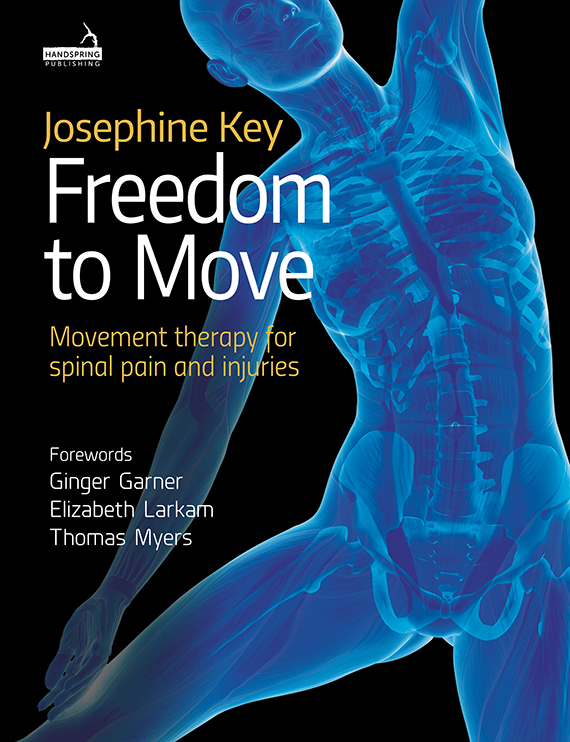
Freedom to Move by Josephine Key
Published by Handspring Publishing 2018
We continue with Part Two of this review of the wonderful resource from Josephine Key – Freedom to Move.
As eluded to in Part One of this review, the Author has excelled at integrating a multitude of complex concepts – particularly in Part B of the book, as she steps into the clinic application of the sound knowledge put forward in Part A.
Knowing the inner-workings of what makes up the curriculum requirements of nationally accredited Pilates training programs, the Part B portion of Freedom to Move would easily transfer to a unit module of study.
It reads like you would expect from an experienced industry expert, with the author generously and extensively detailing her vast experience in applying and communicating the exercise catalogue that she has compiled over the years. The result is a consolidated collection of exercises that has been refined through trial and error – and that the author knows comes together as a complete set – in order to aid participants in returning from the pains of movement dysfunction.
Despite having not worked under the tutelage of the author, my ideology from 20-odd years of teaching Pilates could not be more aligned with the movement objectives of which the author speaks. Perhaps it is due to my fortunate opportunities to work with some of the cited authors of the recommended reading list that I have also seen the benefits in many clients from applying some of the approaches outlined in the book.
As I mentioned in Part One of this review, I found the number of concepts brought together in this text to be at times overwhelming, so I recommend taking your time to allow the information to sink in for you, and encourage you to take a practical approach to the movement elements outlined, as I interpret the author would also advise.
The alternative would be being left with a huge amount of theoretical knowledge that may become more confusing than beneficial. By example, the author has (thankfully!) chosen to compile a glossary list of abbreviations used throughout the book (containing no less than 100 items!) – which otherwise would have made for some very long-winded reading!
The author has also been very generous with providing access to three thorough 1hr-long instructional videos teaching the Key Fundamental Patterns to an example client group.
I found two key highlights stood out for me in this book (among many!). The first, to begin Chapter 6, quotes a researcher by saying:
“Unfortunately the relationship between musculoskeletal disorders and motor behavior is poorly understood and the literature lacks a theoretical framework to guide the development of a more appropriate understanding.” and “Although clinical guidelines emphasize that patients with musculoskeletal disorders should remain physically active, these usually pay no attention to the quality of motor behaviour.”
And the second, of particular note to the Pilates audience for which this review is intended, the author states that “Pilates is an excellent fitness workout if you are young and supple. However, in those with stiffness and poor deep system control it needs careful modification and fine-tuning.… the potential dominance of sagittal plane movements, and ‘working for strength’ without adequate underlying patterns of support and control from the deep system leads to reinforcement of inferior (patterns).” and “this becomes a lot more likely with large classes and inadequate supervision.”
I am so grateful, for the benefit of movement practitioners everywhere, that both of these key points have been so elegantly addressed by the author in the production of this book.
My concern with this book is that the overlay of information the author has brought together, with the nuances of catching all the critical minor details of not only having the observational skills, but also the treatment and teaching skills for movement retraining may well take the best part of the forty years to acquire – the period that the author has practicing as a clinician.
It is clear from the lengths the author has gone to in expanding on her many years of clinical experience that it is her wish that this information aids in raising the bar on the competency standards of both treatment- and movement-practitioners worldwide.
I’ll finish by quoting some other reviewers of this book, whom I agree with wholeheartedly:
“one of the most complete books on movement therapy” Staffan Elgelid, Professor of Physical Therapy
“this comprehensive, evidence-based book belongs on the shelf of any practitioner working with patients or clients suffering from spinal pain and dysfunction. Key clearly articulates the often neglected role of movement re-education” Leila Stuart, Yoga Therapist
Deep gratitude goes to Josephine Key for her contribution to this field with this most wonderful resource. I know I will continue to refer back to it for many years to come, and will continue to recommend it to every colleague I work with.
reviewed by Bruce Hildebrand
PAA comittee member 2020

Comments are closed.